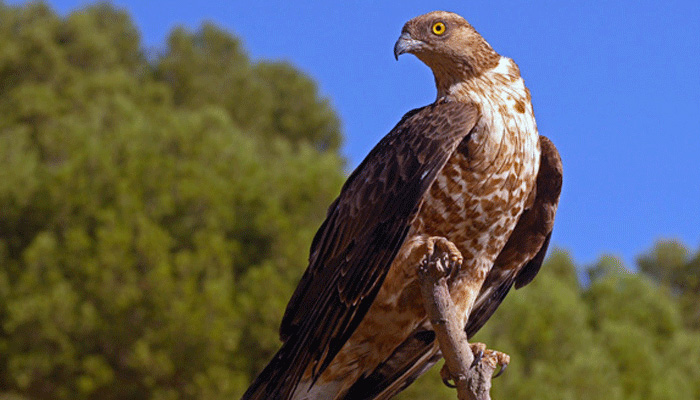
English: European Honey
Buzzard
Russian: Обыкновенный осоед
German: Wespenbussard
French: Bondree
apivore
Mongolian: Балч Гоорбис, Гоорбис
Japanese: ヨーロッパハチクマ (Yoroppa-hachikuma)
Body Length: 52-59
cm
Wing span: 113-135 cm
Habitat:
Summer visitor, wintering in tropical Africa. 2nd-calendar year birds remain in
Africa (exceedingly rare with confirmed records north of Africa), returning to
breed in 3rd-calendar year. Breeds in forests with clearings, glades, small wetlands,
fields. In Britain, rare away from few breeding sites. Food mainly larvae and
nests of wasps, also reptiles, amphibians, nestlings of small birds, worms,
etc. Nests in tall tree, lined with fresh leaves during breeding.
Identification:
Slightly larger and more long-winged than Common Buzzard, but at distance
easily confused with it. At closer range, several finer points of distinction:
neck slim and head held forward in flight in Cuckoo fashion; tail rather long,
about as width of wing, sides slightly convex and corners rounded; head-on
silhouette in glide with smoothly downcurved wings, unlike Common Buzzard in lacking
obvious bend at carpal joints; soars on flattish wings; active flight with slower,
more elastic wingbeats. Plumage variable, incl. dark, medium, pale and rufous
morphs both as adults and as juveniles. Adults usually distinctive, but
juveniles much more similar to Common Buzzard. Common to both age categories is
presence of rectangular or oval-shaped dark carpal patch.
- Adult
♂: Ample ‘hand’ and rather long tail. Only tips of longest primaries black,
sharply set off, prominent black trailing edge to wing; long step to next dark
bar across pale grey flight-feathers; tail similar, prominent dark end-band and
long step to inner one or two narrower dark bars at base; head largely
blue-grey; upperparts brown-grey; upperparts brown-grey, with black bars of
underside visible above as well; cere grey eye yellow.
- Adult
♀: Differs from adult ♂ in having slightly more extensive dark on ‘fingers’,
diffusely set off; shorter step between dark bars at end and base of tail-and
flight-feathers, showing more bars (usually 2 basally, rarely hint of 3rd);
secondaries often dusky, no or rather little blue-grey on head; upperparts dark
brown, hardly showing any bars.
- Juvenile:
Slightly shorter inner primaries and sometimes shorter tail, giving more Common
Buzzard-like silhouette, wing-tips more extensively dark as on Common Buzzard;
flight-feathers more densely barred than on adult (4-5 bars instead of 2-3),
recalling juvenile Common Buzzard (but latter has c.6); secondaries and tail
often darkish, with 4 or 5 evenly spaced bars; cere yellow, eye dark. Dark
morph (fairly common) uniformly dark brown on underbody, lacking pale breast-band
of most Common Buzzards; lightest part on inner underwing is greater coverts
(bases of secondaries on Common Buzzard). Pale and medium morphs often coarsely
streaked on breast/belly, not cross-barred as most adults.